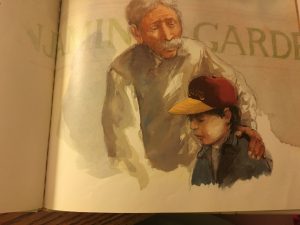
Title: A Day’s Work
Author: Even Bunting
Illustrator: Ronald Himler
Publisher and Year: Clarion Books, 1994
Number of Pages: 32
Genre: Realistic Fiction
Analysis: A Day’s Work is a story about a young boy, Francisco and his grandfather, who go to look for work in America after Francisco’s grandfather moves in with Francisco and his mother. Francisco goes with his grandfather since he does not understand English yet. The two work hard but realize that they have to come back the next day to redo their day’s work.

This book can function as a mirror for those just moving to America from another country. Many experiences that Francisco’s grandfather goes through could also be significant for other people as well. Not knowing English and having to learn English as a second language can be challenging for anyone. This book could also function as a window, for people who speak English to learn about the challenges that others experience when moving to the United States.

Perceptually, the colors from the front cover appear dull, which is not very interesting or engaging for young children. They also appear to be pencil drawings looking like rough sketches, but very detailed. Although the colors are dull and not intriguing, the mysteriousness behind the front cover, invites the reader inside the book to continue reading the story.
Structurally, the images are not framed, which allows the audience to feel invited in and included throughout the book. The text per page with the images is just the correct amount of text so that the reader can understand the text before turning to the next page. The images leave the audience with a mysterious feeling because there is not a clarity in the images, especially the faces, which leaves the reader with an idea about what occurred on that page because of the text but does not provide many details. Since the reader is not able to clearly see the faces of the characters, facial expressions and emotions are hard to see in the images. The illustrator may be trying to make a point about these workers and that workers may not want to specifically have an identity because of frequent job changes or moves.

Ideologically, this book is an excellent example of honesty, loyalty, and that hard work pays off. The grandfather and Francisco are loyal and honest with their employer. Since they completed the wrong job, they were not going to accept payment until the next day when they had completed the job correctly. This example teaches children to always be honest and loyal because these characteristics are valued among adults, parents, and teachers. The easy way out would have been from the grandfather and Francisco to simply accept the money and come out the next day to partially complete the job, but they took the harder route by waiting. Another lesson that this book teaches children is that hard work pays off. Since Francisco and his grandfather took the harder route, they were more valued by their employer, and it could be likely for them to be asked again by this same employer to work for him another time. A Day’s Work is a great book to teach children about morals and values.

